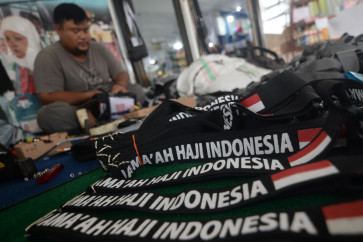Textile industry pins hopes on export recovery
Indonesia expects to see a rebound in textile exports this year following a slump in 2015, as the realized exports in the first quarter (Q1) indicate signs of a recovery
Change text size
Gift Premium Articles
to Anyone

I
ndonesia expects to see a rebound in textile exports this year following a slump in 2015, as the realized exports in the first quarter (Q1) indicate signs of a recovery.
Indonesian Textile Association (API) chairman Ade Sudradjat said Wednesday he expected the value of the country’s textile exports to increase by 4 percent this year from US$12.33 billion recorded in 2015.
He said economic recovery in some of the country’s major trading partners had helped boost textile exports during the first three months of the year, which rose by 3 percent year-on-year (yoy) from $2.3 billion to $2.37 billion.
The increase in the January-March period was encouraging, because the figure in the corresponding period last year had pointed the other way, showing a yoy decline of 2 percent in export value.
Monthly export data reported throughout the rest of 2015 had also shown a declining trend yoy. As a consequence, total textile exports dropped by 2 percent to $12.33 billion last year from $12.74 billion in 2014.
“With the encouraging results in the first quarter, we are hoping to see our textile exports perform better this year,” he said.
Indonesian textile exports failed to make any progress over the last five years, partly due to a decline in orders from the country’s main trading partners. According to data from the Central Statistics Agency (BPS), the value of annual textile exports did not move far from the $13.7 billion recorded in 2011.
Since late last year, the government has issued a series of economic policy packaged aimed at increasing the competitiveness of the country’s manufacturing sector and boosting exports. The packages include, among other things, a simplification of licensing procedures and incentives for labor-intensive industries, which includes the textile industry.
Ade expressed hope that the stimulus packages would make the local textile industry more competitive in the international market.
Meanwhile, Industry Minister Saleh Husin noted Wednesday that the government, in its latest economic package, had included policies to help improve the domestic textile industry.
Indonesia ranks below Vietnam in terms of textile exports, with the latter regarded as the top textile exporter in the region. In 2014, Vietnam’s textile and garment industry witnessed strong growth in exports, which reached a value of US$24.5 billion, up 16 percent from 2013.
Ade attributed Vietnam’s outstanding export performance to the country’s policy to ease business licensing procedures.
“Vietnam’s government requires simpler procedures for its business players. The fact that Indonesia ranks below Vietnam despite a greater population should motivate us,” he said.
While Indonesia’s textile exports diminished slightly over the last five years, textile imports went the other way, rising slightly from $6.52 billion in 2011 to $6.95 billion in 2015.
In reaction to this, Saleh said, aside from raising their exports, local textile producers should also sell their quality products in the domestic market to help curb the influx of imported garments.
“I want business players to focus not only on exports but also on the domestic market,” he said. (adt)
----------------
To receive comprehensive and earlier access to The Jakarta Post print edition, please subscribe to our epaper through iOS' iTunes, Android's Google Play, Blackberry World or Microsoft's Windows Store. Subscription includes free daily editions of The Nation, The Star Malaysia, the Philippine Daily Inquirer and Asia News.
For print subscription, please contact our call center at (+6221) 5360014 or subscription@thejakartapost.com









